 United Kingdom (1926-1929) – 13 heavy cruisers:
United Kingdom (1926-1929) – 13 heavy cruisers:Berwick, Cumberland, Suffolk, Kent, Cornwall, London, Devonshire, Sussex, Shropshire, Norfolk, Dorsetshire, Surrey (cancelled, +1), Australia (RAN), Canberra (RAN)
The staple of Interwar British cruiser Force
With their three funnels, large and tall hull these cruisers were difficult to miss in the Royal Navy, or in any recoignition book of the time. By their numbers and features there are featured prominently in the annals of warfare, and served with distinction in many key events of the second world war. They were much more powerful than the following York and Exeter (one more turret), and were the last British Washington treaty cruisers, not in terms of displacement but of artillery, with the classic “double eight” (eight 8-inches guns) arrangement in four turrets.
When the admiralty went back to 10,000 tons cruisers of the “Town” class from 1936, the fad then was to display more guns of smaller caliber (6 inches) instead. There was in effect a projected 16-18,000 tonnes standard design in 1939 calling for three triple turrets with 8-in guns like American cruisers, but it never materialized. So in essence the County were the first and last of their kind in the Royal Navy, and for this and their large production deserve a special place in history books.
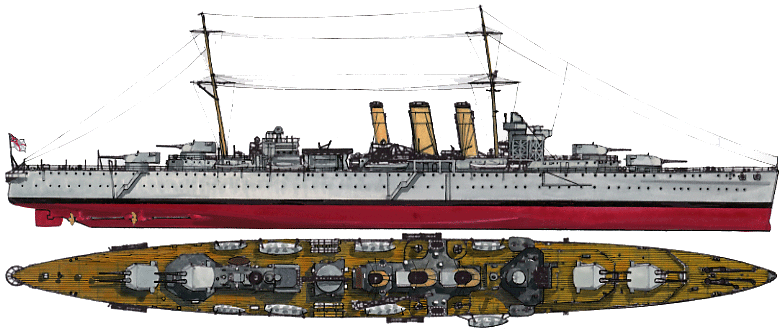
The Kent class general appareance in 1926
Three innovative series
These ships were characterized by a serie of improvements over the previous Hawkins class, still mixing old style shielded single mounts and a single twin turret. The Washington treaty had a tremendous impact on this new design, as the four heavy caliber twin turrets naturally dictated a larger displacement and increased dimensions. The need for versatile cruisers tailor-made for colonial stations, trade protection and escort, and hunting enemy vessels.
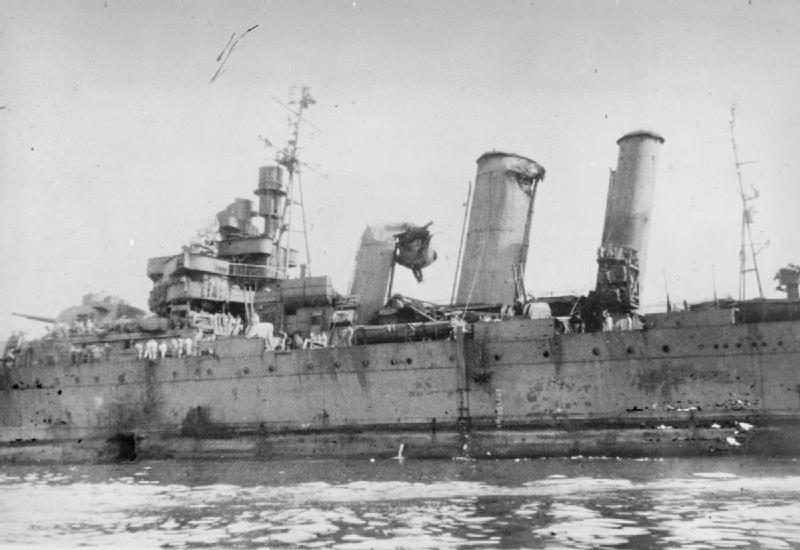
HMAS Australia of the Royal Australian Navy (RAN), in 1942. In 1944 he will be attacked by Kamikaze and will be hit by six aircrafts.
The county class, named after traditional regional aeras of Great Britain (“counties”), was the largest and most used “standard” heavy cruiser class of the Royal Navy during the Second World War. They respected the limits of the Washington treaty, being just under 10,000 tons, with in standard 8 pieces of 8 inches (203 mm) disposed in four double turrets. Designed to operate in remote stations or when the presence of a battleship was superfluous, they had great autonomy and their large hull solidly built and well protected that made them very roomy and almost comfortable ships, they also had “tropical” comfort equipment like air conditioning.
Their crews appreciated them particularly. A total of fifteen ships were produced, in three subclasses (Kent, London, Norfolk) carrying significant improvements, while maintaining their silhouette “three pipers” with a long continuous hull. They were officially classified “A” (“treaty cruisers”) remaining the only ones, the following lightened B (due to the 1929 crisis) or York class having one less turret.
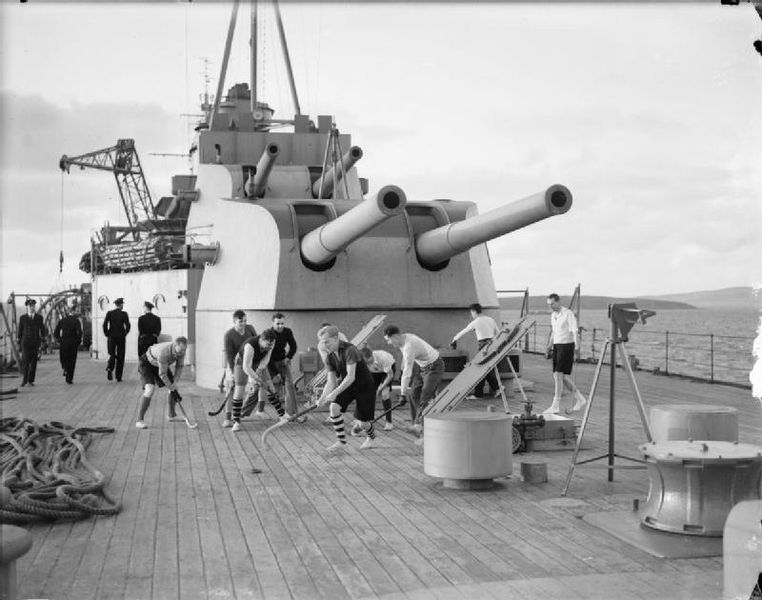
HMS Kent rear turret, with the crew playing hockey in the interwar
Of course, these ships were modernized in the 1930s, receiving radars, sonars, more modern telemetry equipment and a more consistent AA, around the lend-lease 40 mm bofors octuple mounts and 20 mm Oerlikon single mounts, not counting multiple additions during the war. This modernization consisting in an increase of the weight, and to remain within the limits of the treaty, a good part of the back of the hull on the Cumberland and Suffolk of the Kent class (see illustration above) was retired and a large hangar was added for Walrus seaplanes.
The other units of the class (Berwick, Cornwall, Kent) were not modified in the same way, but in the end the limits were exceeded, probably over 10,600 tons or more, which the admiralty did not bother to communicate. They were not handy ships however, the usual tactical diameter being well above 1070 yards.
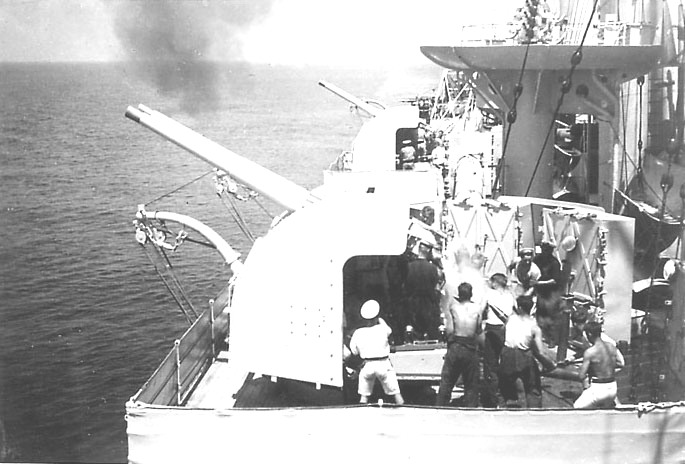
4-in guns of HMS Dorsetshire firing
London class
The London class also included the Devonshire, Sussex and Shropshire was amputated its side ballasts to save weight at the expense of the ASW protection, compensated by the installation of a second internal belt partition… Their hull was slightly elongated, the saving a quarter of a knot. Their command superstructure was moved further back and their funnels lengthened. In 1932 catapults were installed for two aircraft. They also gained 102 mm twin mounts instead of their original single ones, plus four Bofors quadruple mounts, and twin 12.7 mm quadruple mounts.
Between 1938 and 1941, the London was the only one of the class to be completely rebuilt and modernized. But between 1935 and 1939 reconstruction for all ships included the extension of the cemented armour belt, below the lower deck. TTs were often removed also to save weight. Single 2-pdr Pompom were replaced by quadruple ones and for some ships, octuple ones in 1942; Cornwall and Kent. From june 1942 catapults were generally removed as radar was widespread. HMS Australia, reconstructed after a Kamikaze attack saw her X turret removed and 10 twin and 8 single 40mm pompom added.

A tandem quad Vickers .5 (13 mm) heavy machine gun, a common AA systems in the British Navy, less efficient than the Bofors “pom-pom” though.
One of their essential characteristics was ammunition space fairly well protected by 4in cemented armour on the most vulnerable areas and 3in-1in on the above platform deck. There was 1.2 in over the machinery spaces and lower deck protection for the steering gear (30-40 mm). Innovation was also in the use of 70° elevation mounts for the 8-in guns, with charges and shells automatically loaded and rammed in one swoop. The HMS Australia and Camberra, the last of this first London class, had oxygen-enriched Mk.VII torpedoes. The London class and the following only had normal Mk.V models.
Standard armament comprised eight BL 8-inch (203 mm L/50) Mk.VIII in twin mounts Mk.I, abour four to eight QF 4-inch (102 mm L/45) Mk.V in single mounts HA Mk.III, four QF 2 pdr (40 mm L/39) Mk.II in single mounts HA Mk.I, eight QF 0.5-inch (12.7 mm L/50) Mk.III in quad mounts Mk.Iand two quadruple banks of 21 inch (533 mm) torpedoes. Propulsion was assured by Eight Admiralty 3-drum boilers feeding four shaft Parsons geared turbines which together developed 80,000 shp (60 MN) for a top speed of 32 knots (59.3 km/h) and a range of abour 9000+ nautical miles at 12kts.
After being equipped with a catapult, the ships carried one Supermarine Walrus. Some were reconstructed to carry three. However these were discarded during the war when radars were added, and later electronic fire control systems and AA radars. Probably the most compelling reconstruction was performed on the HMS London, which emerged with a brand new massive superstructure, which caused however great stresses on the hull which had to be strengthened later. So it was by chance in some ways, that because of other priorities, this reconstruction was not applied to other ships of the class.

Details of the Walrus seaplane and catapult on board HMAS Australia.
Norfolk class
The Norfolk class which also included HMS Dorsetshire were the last in the series. Their superstructure was lowered and lightened, but their new turrets and 203 mm hulls were heavier in the end. Their DCA was increased considerably and they were the first to be equipped with a type 283 radar. Losses during the war included Cornwall and Dorsetshire (sunk by the Japanese air force off Ceylon on April 5, 1942 at the same time). None was lost in the Atlantic or the Mediterranean. They were scrapped in 1948-1955.
Losses and damage in action:
HMS Cornwall was sunk in 12 minutes by nine bombs and six near-misses and all boilers and engines rooms were flooded and out of action quickly. HMS Suffolk was hit by a 1100 Ib bomb, and had to be beached at Scapa flow aftr steaming for 22 hours at 15 knots, the engines partially flooded and was in repairs for 10 month. HMS Kent was torpedoed by an Italian aircraft and repairs took one year.
Australia was hit by six kamikazes but survived; Camberra was sunk during the Savo Island battle, receiving more than twenty 8-in and lighter rounds before being completely disabled. HMS Cumberland was hit by a 9.4 in shell at Dakar, and her main machinery was put out of action. HMS Berwick engaged KMS Hipper and her belt deflected one 8-in shell, and previously one of her turret was blown off when duelling with Italian cruisers.
Career of the County class ships:
 HMS Berwick
HMS Berwick
She joined the Mediterranean squadron in 1936, underwent reconstruction between 1937 and 1938, Then she joined the America and West Indies Station, 8th Cruiser Squadron based in Bermuda, until the war broke out. She served on ocean convoy escort duties, then was part of Force “F” (with HMS York) hunting German raiders and intercepted the mercantile blockade runners Wolfsburg and Uruguay in March 1940.
9 April 1940: Norwegian Campaign, 10 May 1940: Invasion of Iceland. Then Force “H” at Gibraltar (November 1940). Operation Collar, duelled with Italian heavy cruiser Pola or Fiume. December 1940: She engaged KMS Admiral Hipper off the Canaries as convoy escort to the Middle East. She scored no hits on Admiral Hipper, but sustained a fair amount of damage but saved the convoy. Repairs lasted until June 1941. Then, this was the Home Fleet for the remainder of the war, escorting convoys to North Russia and escorted carriers raiding the Norwegian coast in 1945. She was sold and scrapped in 1949.
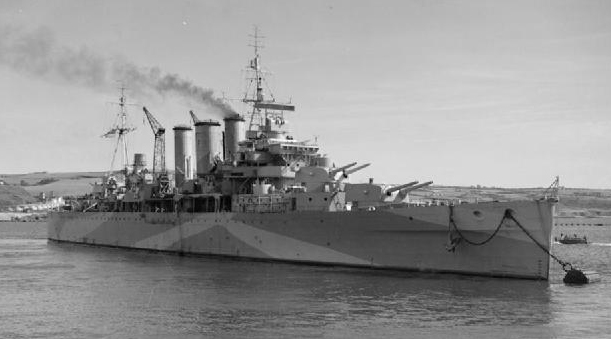
HMS Berwick in 1944
 HMS Cornwall
HMS Cornwall
She was built at Devonport Dockyard, launched on 11 March 1926, completed on 6 December 1927. She was first assigned to the 5th Cruiser Squadron, China Station. In 1930 she received a High-Angle Control System for her anti-aircraft guns, and a catapult. From July 1936, she underwent a major refit: 4.5-inch (114 mm) Krupp cemented armour belt, 4-in armour on the sides of the boiler room fan compartments, hangar for aircraft and new catapult, director moved to the roof of the hangar, new director-control tower, twin-gun mounts for Mark XVI guns, two octuple 2-pounder mounts for 107 long tons (109 t) more in displacement.
She joined afterwards the 5th CS in 1939 and in October 1939 was assigned to Force I, hunting German commerce raiders in the Indian Ocean. She was transferred to the South Atlantic and later was sent to capture Dakar from the Vichy French. She failed to intercept the cruiser Primauguet. She returned to the Indian Ocean, sank the German commerce raider Pinguin on 8 May 1941.
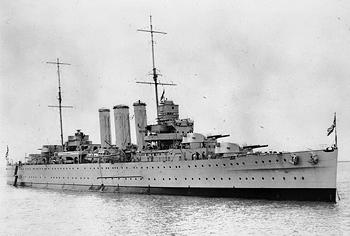
HMS Cornwall in 1929
After the start of the Pacific War she escorted convoys across the Indian Ocean, then was part of fast Force A and on 5 April, she was off Addu Atoll and her planes spotted the Japanese cruiser Tone south-west of Ceylon. What followed was the battle of Easter Sunday Raid. She was struck by Aichi D3A dive bombers and sank, while only part of her crew was later rescued.
 HMS Cumberland
HMS Cumberland
The HMS Cumberland joined the China Station, 5th Cruiser and later was refitted in UK from March 1935. In 1938, she joined the 2nd cruiser squadron (South American station) and in at the start of the Second World War she returned to South America and joined Force G, 2nd Cruiser Squadron. However when the battle of the Rio de la Plata started whe was being refitted in the Falklands.
She arrived when Admiral Graf Spee was already into neutral Montevideo, trapped and later scuttled. She later joined South Africa, Simonstown and escorted convoys along the African coast to the Middle East. She searched for the German commerce raider Thor but intercepted and sank the Vichy French merchant Poitiers, loaded with ammunition for Dakar. She was later damaged there by a French coastal battery.
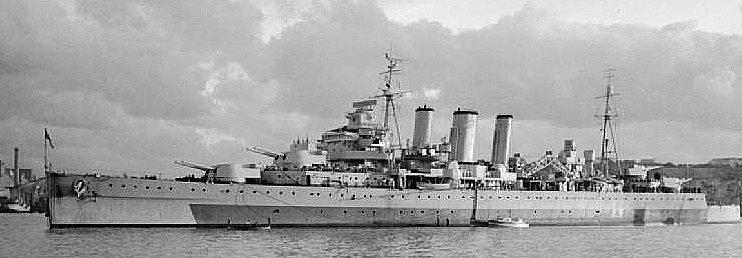
HMS Cumberland
In October 1941 she joined the 1st Cruiser Squadron escorting Arctic convoys until January 1944 (battle honour Arctic 1942-1943). She then sailed for the Far East as part of 4th Cruiser Squadron Eastern Fleet. She covered raids on Northern Sumatra, and won the battle honours Sabang 1944 and Burma 1945.
After the war she transported troops until June 1946, then in reserve until 1949 but refitted at Devonport and emerged in 1951 as a gunnery trials ship with two 8-inch turrets, but was fitted a prototype dual 6-inch automatic turret in ‘B’ position, and prototype automatic dual 3-inch turret in ‘X’ position. She also played in the 1956 film The Battle of the River Plate and afterwards was fitted with trial anti-A-bomb and anti-H-bomb defences and was finally decommissioned in 1958 and sold.
 HMS Suffolk
HMS Suffolk
She served on the China Statio, and was reconstructed until 1939 and from then on patrolled the Denmark Strait. In April 1940 she participated in the Norwegian Campaign and covered the Faroe Islands. landings, sinking the German tanker Skagerrak off Bodø. Together with four destroyers she shelled later the airfield at Sola but was damaged by German bombers. She was back to Scapa Flow for repairs which latest until February 1941 at the Clyde.
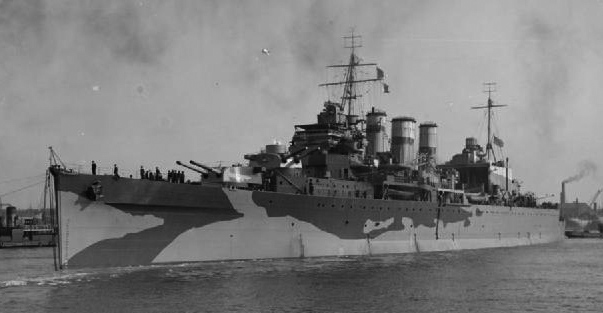
HMS Suffolk on the Tyne, 1944
In May 1941 HMS Suffolk took part in the Battle of the Denmark Strait (battleship Bismarck), engaging the battleship twice and tracked her using her radar through the Denmark Strait and maintained contact, allowing other units to rally. She shadowed the Bismarck after the battle with Hood and PoW, but was forced to join Iceland, low on oil.
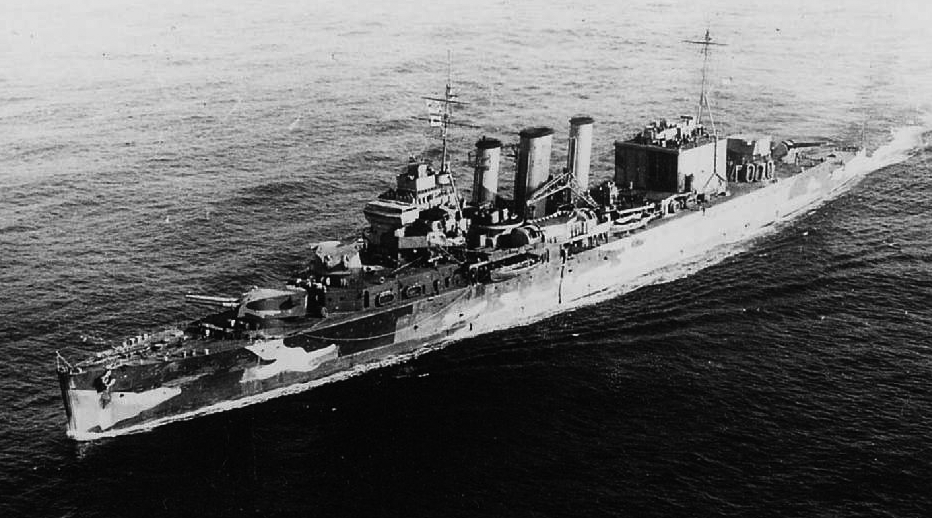
HMS Suffolk in May 1941, at the time of the hunt for the Bismarck
She later joined the 4th Cruiser Squadron and served with the Home Fleet in Arctic waters until the end of 1942. Her “X” turret was removed in a new refit, and she receive additional AAA, then sailed for the Eastern Fleet, in the Indian Ocean, patrolling there until the end of the war. She was placed in reserve until 1948, was sold off, and scrapped.
 HMS Kent
HMS Kent
Like the other “County” cruisers she was at first sent to the China Station but also passed through the standard major refit of 1937–38. She was back in China in 1939. She then took part in the hunt of battleship Admiral Graf Spee in the East Indies in late 1939. She was later reassigned to troop convoy escort duties in the Indian Ocean in early 1940, and transferred to the Mediterranean. There at Alexandria in August 1940 she joined the 3rd Cruiser Squadron (battleships Warspite, Malaya, Ramillies) and shelled Italian positions near Bardia and Fort Capuzzo. She took part in many other operations until late September, in particular around Benghazi.
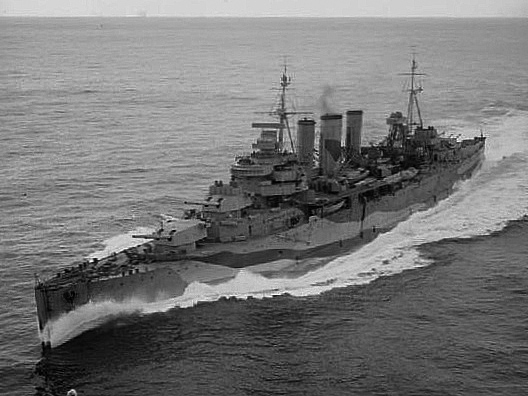
HMS Kent in 1944
However she was later torpedoed by Savoia-Marchetti SM.79 bombers from the 279th Independent Torpedo Squadron, badly hit, towed to port and under repair until late 1941. She was back with the Home Fleet, taking part to convoy missions to Mourmansk. In mid-1944 she covered several carrier’s attacks on Norwegian German bases and merchant traffic and against the Tirpitz (Operation Mascot, and then Operation Counterblast). She also intercepted a German convoy and sank two freighters and five escorts. Paid off in early 1945, in reserve and used as a target she was eventually was sold to breakers in 1948.
 HMAS Australia
HMAS Australia
Both Australian cruisers has been started in 1925 at John Brown & Company, Clydebank. The career of this cruiser was quite long and agitated and would deserve her own post. She entered service in 1928 with the RAN. She was deployed first to the Mediterranean from 1934 to 1936, taking part in the British response to the Abyssinia Crisis. She then joined as planned the South-West Pacific waters and remained near Australia until mid-1940.
She sailed to the eastern Atlantic searching for German ships and Operation Menace. The next year she operated in home and Indian Ocean waters, and finally became the flagship for the ANZAC Squadron in early 1942, later renamed Task Force 44, and Task Force 74. She operated with US units covering amphibious landings until the start of 1945.
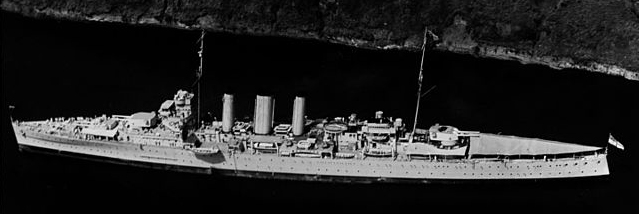
HMS Australia through the Panama Canal in March 1935
Operations and most memorable actions included the battles of the Coral Sea and Savo Island, Guadalcanal and Leyte Gulf, plus the whole New Guinea campaign. She was eventually attacked by a series of kamikaze attacks in the Lingayen Gulf. She was badly hit, survived several impacts but was declined later any repairs in Australian shipyards because of other priorities. Summarily repaired she had to sail to UK and still there at the end of the war.
During the late 1940s, Australia served with the British Commonwealth Occupation Force in Japan, and participated in several port visits to other nations, before being retasked as a training ship in 1950. The cruiser was decommissioned in 1954, and sold for scrapping in 1955.
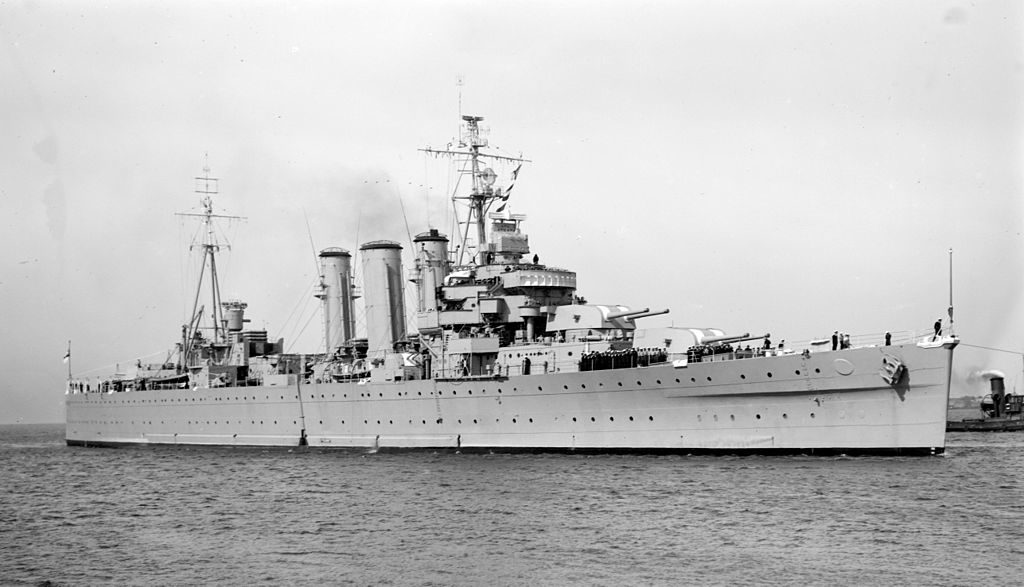
HMAS Australia in 1953
 HMAS Camberra
HMAS Camberra
This second RAN cruiser was in service by 1928 and alternated between deployments in Australian waters and the China Station. She patrolled around Australia but was reassigned in June 1940 to escort shipping between Western Australia, Sri Lanka, and South Africa.
By mid-1941, she was involved in hunting German auxiliary cruisers and commerce raiders. She was back in Australian waters when Pearl harbor happened, and quickly reassigned to patrol around New Guinea, only leaving this theater to operate in Malaysian and Javanese waters. The RAN cruiser joined Task Force 44, and soon was plunged into the deadly battles of the Guadalcanal Campaign and Tulagi landings.

HMAS Camberra at King’s warf in Australia before the war
On 9 August 1942, she opened fire the Battle of Savo Island, and was badly damaged, evacuated and sunk in the infamous “Ironbottom Sound” by American destroyers. More in detail, in the afternoon of the previous day, a Japanese task force (Vice Admiral Mikawa) of five cruisers and a destroyer was spotted at the south of Savo Island, bound to attack US landing operations at Guadalcanal and Tulagi.
The Allied commander of the combined naval forces, British Rear Admiral Victor Crutchley, which raised hi mark on the HMAS Australia split his forces and led his ships, accompanied with USS Chicago, and two destroyers on the southern waters. But when the evening was falling he was recalled urgently by Admiral Richmond K. Turner at the head of the amphibious landings. During the night, Mikawa’s observation seaplanes were heard, and past 01:45, Patterson spotted Mikawa’s fleet and alerted the fleet. The Japanese seaplanes soon dropped flares to light Canberra and Chicago. and while the cruiser was able to dodge at first a volley of Japanese torpedoes, gunfire concentrated on her.
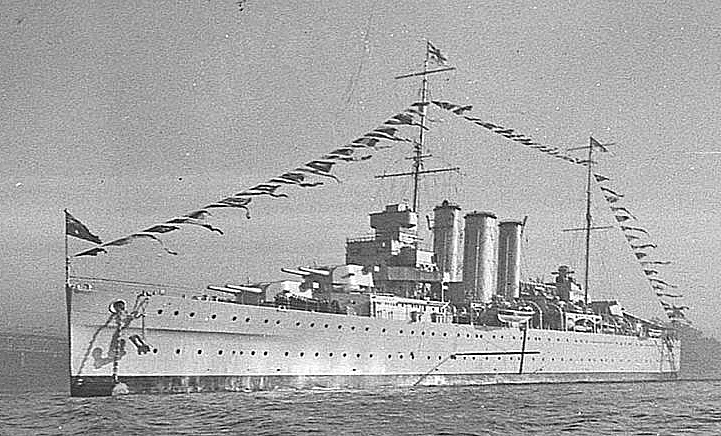
HMAS Camberra at Sydney in 1936
Soon the bridge, and the engine rooms were badly damaged and the 8-inch magazines were flooded. She was hit 24 times by heavy caliber, lost power, listed to starboard, in fire from stern to stem, with a fifth of her crew missing or disabled. One torpedo strike was reported, and eventually at 03:30, she received orders by Rear Admiral Turner to be abandoned and sunk. While a destroyer rescuing survivors spotted an approaching ship, a friendly fire erupted with USS Chicago, which had mistaken Canberra for a damaged Japanese vessel. By 06.30 the ship’s engines rooms cannot be repaired and towing her was considered too dangerous, so she was scuttled, torpedoed by the destroyer USS Ellet at 08:00 after USS Selfridge hit her 263 times, and fire four torpedoes, and was the first ships sunk in the future “Ironbottom Sound”.
Her battles honors comprised the “East Indies 1940–41”, “Pacific 1941–42”, “Guadalcanal 1942”, and “Savo Island 1942”.
Later in the war, the only United States Navy Baltimore-class cruiser named after a foreign city was designated USS Canberra to pay homage to the Australian ship and her crew.
London class carrer
 HMS London
HMS London
In service by 31 January 1929 she served with the 1st Cruiser Squadron until March 1939, flagship of Admiral Max Horton, commanded by Henry Harwood. In 1937 with HMS Sussex she cruised in Italy, visiting Venice and later with HMS Shropshire helped evacuate thousands of civilians from Barcelona (Spanish Civil War).
Just before the war in 1939 she was back at the Chatham Dockyard for a complete reconstruction with a brand new superstructure and new funnels, emerging like a massive Crown Colony-class light cruiser. 4-inch twin gun mounts, 20mm AA guns and radar were also added as well as a 3½-inch cemented armoured belt covering the engine rooms and emerging two years later in March 1941. This particular refit planed for other ships but never carried out.
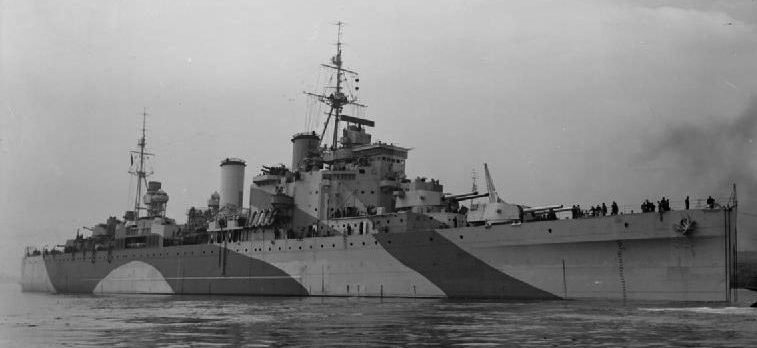
HMAS London as reconstructed
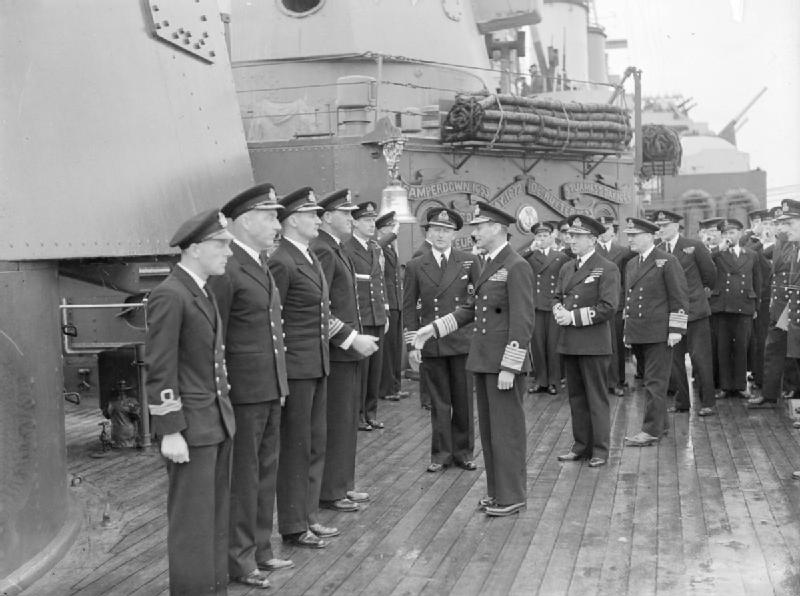
King Georges V onboard HMS London, meeting the crew
In May, she arrived on time to chase off the German battleship Bismarck in May 1941 but it seemed her new superstructure causing stresses on the hull which cracked and the ship was quickly refitted in a commercial shipyard on the River Tyne from October 1941 until February 1942.
Then until November 1942 she escorted convoys in the North Atlantic, the North Atlantic seas causing more hull cracks, another refit from December 1942 along with the replacement of the radar, and more light AAA the work being completed in May 1943. She then was sent in South African waters and the Eastern Fleet for the remainder of the war. She was scrapped in 1948.
 HMS Devonshire
HMS Devonshire
Completed on 18 March 1929, she joined the 1st Cruiser Squadron of the Mediterranean Fleet and stayed there until 1939, with a short sortie in 1932–33 tour with the China Station. She suffered a serious accident on 26 July 1929 during gunnery training off Skiathos in the Aegean. While repaired in UK she received a High-Angle Control System and a catapult, plus four more single four-inch AA guns and tow quadruple Vickers .50-calibre (12.7 mm) Mark III machine guns (1937). She also sailed to Marseille, France, with 452 Spanish Republican refugees on board from Menorca in 1939.
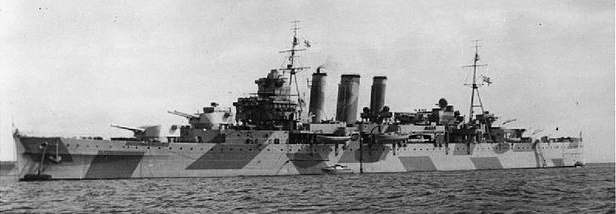
HMS Devonshire in her Mediterranean camouflage
She then returned in the Home Fleet and sailed from the Clyde to attempt to find the Scharnhorst and Gneisenau. From March 1940 she carried the flag of the future First Sea Lord, Vice-Admiral John H. D. Cunningham and patrolled off Scotland, the Faeroe Islands and Iceland and escorted ships carrying troops in Norway, from Rosyth to Stavanger and Bergen. But soon the Germans invaded, and the cruiser was attacked by German bombers, which missed. This happened again in May when she covered the evacuation of British and French troops from Namsos. She also evacuated King Haakon VII, Crown Prince Olav, and Norwegian government officials including the Prime Minister from Tromsø in June.
After the Norwegian Campaign, she participated in the attack of Vichy France Dakar, in Senegal, together with the Australia. When the Barham was torpedoed, the admiral raised the flag on her. She shelled the harbour, firing 200 without success as the later was covered by concealing smoke. She later evacuated personal and blockaded the coast of Gabon while her seaplane spotted the French submarine Poncelet, which was sunk.
Still in the south Atlantic she searched for the raider Kormoran in January 1941. She was refitted in Liverpool 19 February–22 May and received the new radar and more AAA. Back in action she escorted convoys in the North sea, bound to Petsamo and Norway, then the first convoy to Russia, Operation Dervish. She also later captured a Vichy convoy bound for French Indochina off South Africa and later sank the axuliary German cruiser Atlantis. She sailed to the USA and was refitted in Norfolk, Virginia from 24 January to 7 March 1942, gaining a new radar and a more impressive AAA.
She joined 4th Cruiser Squadron of the Eastern Fleet bound to Vichy-held Madagascar to prevent the Japanese to use the Island (Operation Ironclad). She remained in the Far East until May 1943, escorting convoys between Suez and Australia and back. She then went back home for another refit until 20 March 1944 and until the end of the war escorted convoys and covered operations in Norway.
 HMS Sussex
HMS Sussex
She served in the Mediterranean until 1934 and operated with HMAS Australia until 1939 defending neutral shipping along the eastern Spanish coast in the last days of the Spanish civil war. When the war broke out she was sent to the Atlantic theatre, operating with Force H in the South Atlantic and Indian Ocean, searching for the Admiral Graf Spee. With HMS Renown she intercepted the German passenger ship Watussi and later returned to the UK, and served in the Norwegian Campaign.
She was refit at Liverpool in March to May 1940 and joined 1st Cruiser Squadron in Scapa Flow. Later while undergoing work in drydock because of a propulsion defect at Stephen’s shipyards, Govan, she was struck by German bombers on 18 September 1940, and needed more extensive repairs until August 1942. She would receive a new radar, fire control and additional Oerlikon 20 mm and Pom Pom eight barrel systems.
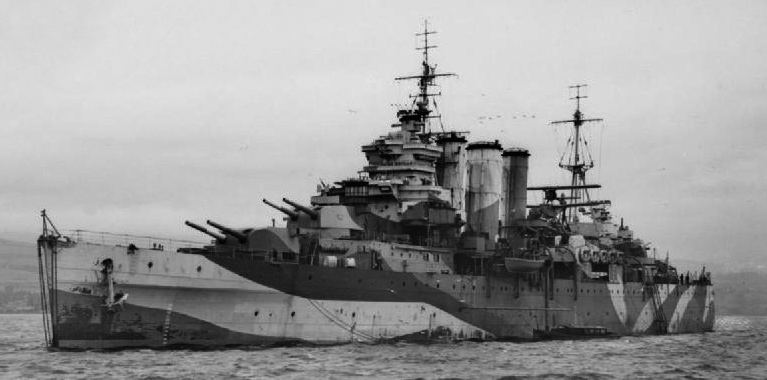
HMS Sussex
She was back in Scapa flow and was refitted at the Tyne shipyard, and when out in January 1943 she joined 1st Cruiser Squadron and 4th Cruiser Squadron of the Eastern Fleet in the Indian Ocean, intercepting and sank the German tanker Hohenfriedburg while en route but attacked by German submarine U-264, avoiding her four torpedoes. She spent 1944 in the Pacific covering operations in the East Indies after the cessation of hostilities but was attacked in July 1945 by kamikazes, one badly damaging her side. She would later enter Singapore to receive General Seishirō Itagaki’s surrender.
 HMS Shropshire
HMS Shropshire
The British cruiser spent her early life under British flag but would later be passed on to the RAN, replacing HMAS Australia. She served with 1st Cruiser Squadron of the British Mediterranean Fleet, took part in the British response in the Abyssinia Crisis and Spanish Civil War, supporting the evacuation of refugees from Barcelona. After the war broke out, she was sent to the South Atlantic for escort duties intercepting German merchant Adolf Leonhardt, was refitted in early 1940 in UK and sailed to the Indian Ocean for more escort patrols on the Cape Town-Durban-Mombassa-Aden line.
She also was deployed off Italian Somaliland in 1941 shelling Mogadishu and Kismayu. She was refitted at Simon’s Town until June 1941, then again in October 1941 at Chatham until March 1942, then back to South Atlantic and again back in UK. Then she was transferred to the RAN as a gift, announced by the King on 10 September 1943. However she has not renamed Canberra as in between president Roosevelt announced that a new under-construction Baltimore-class cruiser USS Pittsburgh would be renamed USS Canberra.
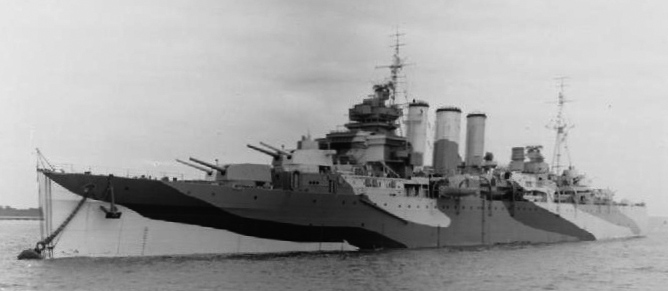
HMS Shropshire
HMS Shropshire meanwhile underwent another refit at Chatham until 20 June 1943 and she was recommissioned in the RAN from 17 April with the new crews arrived well before the end of her refi to train. From August she escorted a convoy to Gibraltar and arrived in Sydney on 2 October. She supported amphibious landings at Arawe and Cape Gloucester, then took part in the Admiralty Islands campaign, covered the landings at Hollandia, patrolled in the Wakde-Sarmi-Biak area, and after another refit in Australia served with distinction in Aitape and Cape Sansapore, Morotai and Leyte Gulf in early October 1944.
As part of Task Force 77, she was involved in the Battle of Surigao Strait, and after that, the Battle of Luzon, attacked by two kamikaze aircraft, both missing (one shot down). She also covered the Corregidor landings and was back in time from Australia in the Philippines for the Japanese surrender. She was also at Tokyo Bay on 2 September 1945. She transported Australian soldiers home and operated from January until March 1947 in Japanese waters. She was sold on 16 July 1954 to a Dutch shipbreaker.
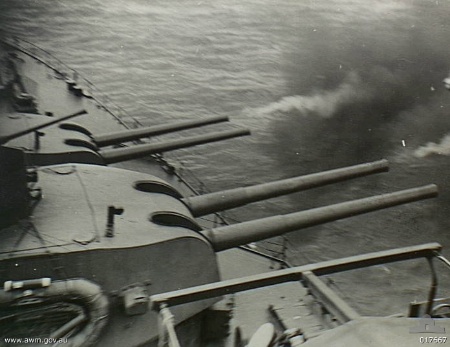
HMAS Shropshire firing at the battle of Morotai
 HMS Norfolk
HMS Norfolk
The British heavy cruiser served prior to the war in the East Indies Station. She was refitted in 1939 and was deployed with the 18th Cruiser Squadron, taking part in the hunt of battleships Gneisenau and Scharnhorst, and later Admiral Scheer. She was repaired for battle damage in Belfast, and was attacked by an air raid by Kampfgeschwader 26 at Scapa Flow on 16 March 1940, repaired once more on the Clyde. By December 1940, she sailed to the South Atlantic, Force K hunted the Admiral Scheer and, and the auxiliary cruiser Kormoran.

HMS Norfolk escorting a Convoy to Mourmansk
In May 1941 she returned to Icelandic waters, and spotted the German battleship Bismarck, to trailing the German battleship and was present to sink her at the end. From September 1941 she escorted ships on the dangerous Arctic Convoys road and engaged the Scharnhorst on 26 December 1943, scoring three hits but receiving several 11-in hits but occupying her enough to be caught and sunk by the battleship Duke of York.
She was repaired and refitted on the Tyne, losing her damaged X-turret in favour of additional AAA but missed the D-day landings. As flagship of Vice Admiral Rhoderick McGrigor she fought in Operation Judgement, an attack on an U-boat base in Norway and the last air-raid of the war in Europe. After the war she was refitted at Malta and served in the East Indies until being retired.
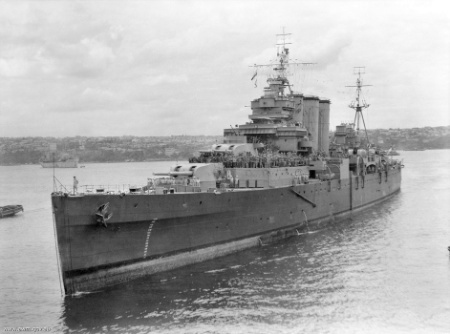
HMAS Shorpshire at Sydney in 1945
 HMS Dorsetshire
HMS Dorsetshire
When the war broke out, the cruiser was on the China Station, but then sailed to South American waters chasing Admiral Graf Spee.
Later on together with the Cornwall and aircraft carrier Eagle sailed to Simonstown in South Africa. From there she sailed from Colombo on 9 December, to Tristan da Cunha and Port Stanley (Falkland Islands) learning about the Graf Spee scuttling in between. Dorsetshire escorted the HMS Exeter back to Britain in January 1940. Back in South American waters her planes spotted the German freighter Wakama off Brazil, scuttled by her crew before she arrived.
However this was a violation of Brazilian waters, quickly called by the press the Wakama incident. After a refit in Simonstown, then in UK, she was sent to search for French battleship Richelieu, which left Dakar for Casablanca. She met the aircraft carrier Hermes off Dakar buy was later attacked by French submarines Le Héros and Le Glorieux but evaded their torpedoes.
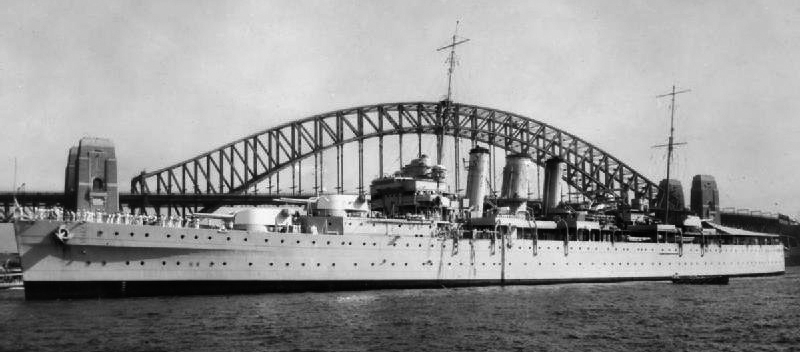
HMS Dorsetshire at Sydney
In September, she was back at Durban, then Simonstown, and sailed for Sierra Leone and the Indian Ocean. She shelled Zante in Italian Somaliland, searched for the Admiral Scheer and in late May 1941, she searched for the Bismarck, and remained south of Bismarck’s route and later took part in her last battle, opening fire at a range of 20,000 yards (18,000 m) and firing 254 shells from her main battery. In the final moments of the battle, she was ordered to move closer and torpedo Bismarck and fired three torpedoes, two of which on the feared German battleship. She also picked up 110 survivors.
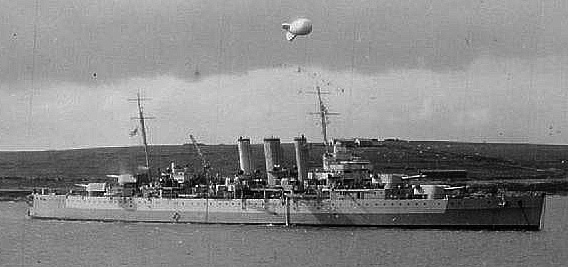
HMS Dorsetshire at Scapa Flow in 1941
In late August 1941, HMS Dorsetshire searched for the Admiral Hipper and later escorted a convoy from Halifax to Basra, Iraq. In December she was diverted to Bombay and hunted the commerce raider Atlantis but intercepte the German U-boat supply ship Python instead. By 1942 under her new commander Augustus Agar, she joined Eastern Fleet in the Indian Ocean, then Force A (Admiral James Somerville) with the Warspite, Indomitable and Formidable.
On 5 April, while withdrawing to refuel at Colombo the Dorsetshire and her sister ship Cornwall were spotted by Japanese reconnaissance aircraft from the Tone and later attacked by fifty-three Aichi D3A Val dive bombers southwest of Ceylon. The Dorsetshire was hit by bombs and several near misses and sank stern first at 13:50, rapidly and survivors (1000+ for both ships) were rescued by cruiser Enterprise, destroyers Paladin and Panther the next day.
London class specifications, Second County Class |
|
| Dimensions | 193 m, 20m, 6.4m (633 ft x 66 ft x 21 ft) |
| Displacement | 9,750 tons standard, 13,315 tons full load |
| Crew | 784 officers and enlisted men |
| Propulsion | 8 Admiralty 3-drum boilers, four shaft Parsons geared turbines 80,000 shp |
| Speed | 32 knots (59.3 km/h) |
| Range | 9,120 nm at 12kts |
| Armament | 8 × BL 8-inch (203 mm L/50), 4–8 4-inch (102 mm L/45), 4 x pdr (40 mm L/39), 8 × QF 0.5-inch (12.7 mm L/50) 8 × 21-in (533 mm) TTs. |
| Armor | Belt 38-64 mm (1.5-2.5 in), decks & bulkheads 38-51 mm (2 in). |
Links/sources
wiki
on steelnavy.com
Conway’s all the world’s fighting ships 1922-1947
Profiles

HMAS Australia in 1942

HMS Norfok, of the last serie (1928)

HMS Suffolk as rebuilt to operate seaplanes, as for 1941

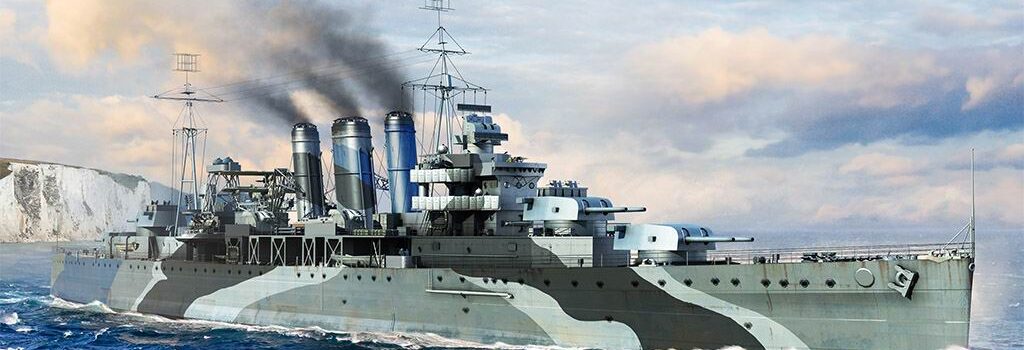
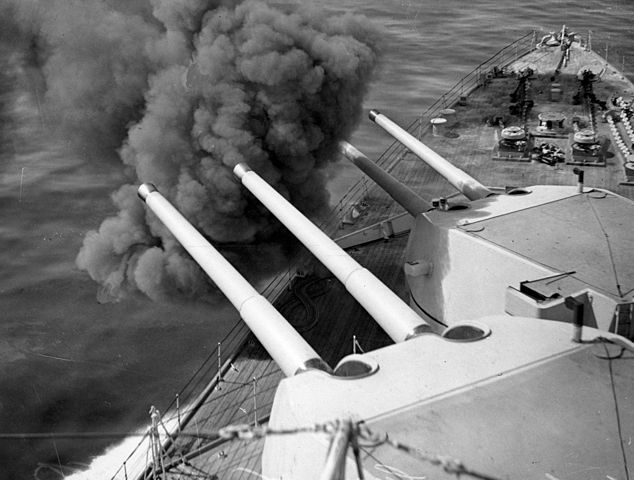


 Latest Facebook Entry -
Latest Facebook Entry -  X(Tweeter) Naval Encyclopedia's deck archive
X(Tweeter) Naval Encyclopedia's deck archive Instagram (@navalencyc)
Instagram (@navalencyc)





 French Navy
French Navy Royal Navy
Royal Navy Russian Navy
Russian Navy Armada Espanola
Armada Espanola Austrian Navy
Austrian Navy K.u.K. Kriegsmarine
K.u.K. Kriegsmarine Dansk Marine
Dansk Marine Nautiko Hellenon
Nautiko Hellenon Koninklije Marine 1870
Koninklije Marine 1870 Marinha do Brasil
Marinha do Brasil Osmanlı Donanması
Osmanlı Donanması Marina Do Peru
Marina Do Peru Marinha do Portugal
Marinha do Portugal Regia Marina 1870
Regia Marina 1870 Nihhon Kaigun 1870
Nihhon Kaigun 1870 Preußische Marine 1870
Preußische Marine 1870 Russkiy Flot 1870
Russkiy Flot 1870 Svenska marinen
Svenska marinen Søværnet
Søværnet Union Navy
Union Navy Confederate Navy
Confederate Navy Armada de Argentina
Armada de Argentina Imperial Chinese Navy
Imperial Chinese Navy Marinha do Portugal
Marinha do Portugal Mexico
Mexico Kaiserliche Marine
Kaiserliche Marine 1898 US Navy
1898 US Navy Sovietskiy Flot
Sovietskiy Flot Royal Canadian Navy
Royal Canadian Navy Royal Australian Navy
Royal Australian Navy RNZN Fleet
RNZN Fleet Chinese Navy 1937
Chinese Navy 1937 Kriegsmarine
Kriegsmarine Chilean Navy
Chilean Navy Danish Navy
Danish Navy Finnish Navy
Finnish Navy Hellenic Navy
Hellenic Navy Polish Navy
Polish Navy Romanian Navy
Romanian Navy Turkish Navy
Turkish Navy Royal Yugoslav Navy
Royal Yugoslav Navy Royal Thai Navy
Royal Thai Navy Minor Navies
Minor Navies Albania
Albania Austria
Austria Belgium
Belgium Columbia
Columbia Costa Rica
Costa Rica Cuba
Cuba Czechoslovakia
Czechoslovakia Dominican Republic
Dominican Republic Haiti
Haiti Hungary
Hungary Honduras
Honduras Estonia
Estonia Iceland
Iceland Eire
Eire Equador
Equador Iran
Iran Iraq
Iraq Latvia
Latvia Liberia
Liberia Lithuania
Lithuania Mandchukuo
Mandchukuo Morocco
Morocco Nicaragua
Nicaragua Persia
Persia San Salvador
San Salvador Sarawak
Sarawak Uruguay
Uruguay Venezuela
Venezuela Zanzibar
Zanzibar Warsaw Pact Navies
Warsaw Pact Navies Bulgaria
Bulgaria Hungary
Hungary

 Bundesmarine
Bundesmarine Dutch Navy
Dutch Navy Hellenic Navy
Hellenic Navy Marina Militare
Marina Militare Yugoslav Navy
Yugoslav Navy Chinese Navy
Chinese Navy Indian Navy
Indian Navy Indonesian Navy
Indonesian Navy JMSDF
JMSDF North Korean Navy
North Korean Navy Pakistani Navy
Pakistani Navy Philippines Navy
Philippines Navy ROKN
ROKN Rep. of Singapore Navy
Rep. of Singapore Navy Taiwanese Navy
Taiwanese Navy IDF Navy
IDF Navy Saudi Navy
Saudi Navy Royal New Zealand Navy
Royal New Zealand Navy Egyptian Navy
Egyptian Navy South African Navy
South African Navy






























 Ukrainian Navy
Ukrainian Navy dbodesign
dbodesign
Dear Sirs
My name is Jonathan Joseph Strong of Berwyn Pennsylvania and i’m writing a whole series of science-fiction novels using every type of warships from sailing warships to the 21st Century computerized warships Did you ever seen the Final-Countdown when the USS Nimitz went through some-kind of storm for there is no reason for it And can you guess where they had ended up? Here a idea Saturday December the Sixth 1941! So the Nimitz’s captain had a Hobson’s choice to ponder on If they sink the Japanese aircraft-carriers they would be changing history But if they didn’t 2,403 men who had died on Sunday December 7th 1941 would happened But in my own story-lines i don’t used a single aircraft-carrier i used whole fleets of one And i use the weather just like in the Final-Countdown but with a little something better ET phone-home would you believe it! And there were other ships aircraft and soldiers that had vanished into thin-air years or centuries ago Some that were real like the Nimitz or the World-War-2 Fletcher-class destroyers Or either early Cold-War warships and early Cold-War nuclear-attack and ballistic missile-submarines Or warships which was in the scenario that the Cold-War which who had never ended in the 1990’s that Mikhail Gorbachev which who was removed from his seat of office by the hardliners in the military and the Soviet-government which who didn’t like glasnost and they had felt that if it kept going he would make the Western-Powers believe that the Soviet-Union which who was being weakened by Gorbachev’s downsizing the forces that protected the Soviet-Union from the West This failed because of the coup fell completely apart in August 1991 But suppose they succeeded and the Cold-War had continued? PLEASE HELP ME IN THIS! If you can’t reach the Google mail address my regular mailing address is 237 Leopard Rd Berwyn Pennsylvania 19312 I remain Jonathan J Strong
Hello Jonathan, if you have precise questions about some ships i’ll do my best to answer these.
Best luck with your fiction
David
Hi – great site and with an image of CANBERRA’s forecastle which I had been searching for (well, any of the Kents would have done, but it’s a rare picture). Noticed a couple of errors though in the captions of your other images:
1. “HMS Devonshire, of the Kent class (1926)” – I believe DEVONSHIRE was a LONDON rather than a KENT.
2. “The Famous single, quad and octuple “Pom Pom” Bofors QF 2-pdr, one of the most effective AA systems in the British Navy.” – The image isn’t a 2 pdr pompom, but of a quad 50 cal. Also, I also wonder if one could truly argue that the pompoms were all that effective, at least more so than 20mm Oerlikons or 40MM Bofors?
Minor points though – keep up the good work!
May I draw your attention to the Colour drawing of HMS Devonshire 1926. which is incorrect.
HMS Devonshire belonged to the London class and not to the Kent Class as stated. Also HMS Devonshire did not have a stern
catwalk . I think the ship is either HMS Kent or HMS Dorsetshire.
I hope you find this information useful.
Regards
Dennis Vella
Hello Dennis, it’s a fairly old illustration and it’s well possibly a legend mismatch between the Devonshire and Dorsetshire. Without tracing back the origin i fixed the legend. Like other WW2 cruisers, one day the post will receive a brand new set of HD illustrations.
Best,
David
The image labelled as a 2-pdr bofor is that of a .50 cal Vickers.
Identification confirmed, and fixed, thanks !
“more consistent AAA, around the classic 40 mm bofors octuple mounts (the famous “pom-pom”) and 20 mm Oerlikon”
The Bofors and the 2pdr pom-pom 40mm are different weapons entirely.
The 2pdr a water cooled gun built by Vickers, the Bofors a Swedish (also 40mm) air cooled weapon; the pom-pom was produced in the octuple mounts, the Bofors only in x1, 2, 4 and 6 mountings. It is confusing but check Wikipedia and other places if you don’t believe me.
Fixed ! They are indeed entirely different weapons, only sharing the caliber.